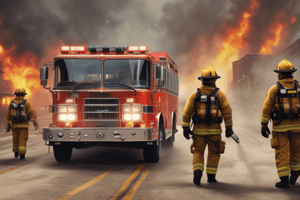Podcast
Questions and Answers
What is the purpose of relay pumping operations in Toronto Fire Services?
What is the purpose of relay pumping operations in Toronto Fire Services?
- To move water from the supply to the fire scene at excessive pressures
- To reduce the amount of water supplied to the fire scene
- To utilize all available ports of a hydrant
- To provide all personnel with a guideline for relay pumping operations (correct)
Who is responsible for ensuring relay pump operations are properly established and carried out?
Who is responsible for ensuring relay pump operations are properly established and carried out?
- All personnel
- Incident Commander
- Company Officers (correct)
- Water Supply Sector Officer
What is the maximum pressure required to set up relay pumping operations?
What is the maximum pressure required to set up relay pumping operations?
- 1400 kPa (correct)
- 1600 kPa
- 1000 kPa
- 1200 kPa
What size of supply hose is used for relay pumping operations?
What size of supply hose is used for relay pumping operations?
What is the maximum distance between the Source Pumper and the hydrant?
What is the maximum distance between the Source Pumper and the hydrant?
What is the maximum distance between pump apparatus in a relay?
What is the maximum distance between pump apparatus in a relay?
What is the maximum amount of hose between the Supply Pumper and Aerial/Quint?
What is the maximum amount of hose between the Supply Pumper and Aerial/Quint?
What is the maximum distance between the Supply Pumper and Aerial/Quint when the Aerial is equipped with its own fire pump?
What is the maximum distance between the Supply Pumper and Aerial/Quint when the Aerial is equipped with its own fire pump?
Study Notes
Relay Pumping Operations
- Relay pumping is set up when excessive pressures (greater than 1400 kPa) are required to move water from the supply to the fire scene, or when Net Discharge Pressures limit the water supply.
Equipment and Setup
- 100mm supply hose should be used for relay pumping operations.
- Source Pumpers should be positioned no more than 30 meters from a hydrant.
- Source Pumpers should utilize all available ports of a hydrant and use 100mm hose for connections.
- Distance between pump apparatus in a relay should not exceed 12 lengths (180 meters) of 100mm hose when a single supply line is used.
Aerial Waterway Operations
- When relaying to an Aerial waterway (Aerial with no pump or straight into a Quint’s waterway), the maximum amount of hose between the Supply Pumper and Aerial/Quint should be no more than 30 meters (100 feet).
- If the Aerial is equipped with its own fire pump (Quint) and the supply pumper is feeding it, the distance can be increased to a maximum of 12 lengths (180 meters) because crews have positive control over their own discharge pressures.
Communication and Pressure Maintenance
- Pump operators involved in a relay should remain in frequent radio communication with the respective Sector Officer and other apparatus in the relay.
- Pump operators should ensure a minimum 140 kPa residual pressure is maintained (if using a pressurized source).
Studying That Suits You
Use AI to generate personalized quizzes and flashcards to suit your learning preferences.
Description
Guidelines for Toronto Fire Services personnel on relay pumping operations, including responsibilities of Company Officers and the Incident Commander.



